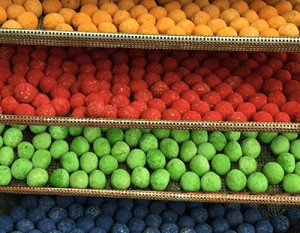Pros, cons, and recommendations
You have a vision of green pastures a-buzz with bees, leaping antelopes grazing on native prairie grasses. Or maybe you are sick of seeing the eroding barren soil on the abandoned lot that you pass everyday. Seed balls might be the solution. There are a few different kinds of seed balls, and this article is meant to clarify the distinctions and discuss the pros and cons of each.
Many-Species-in-One Seed Bomb
These seed bombs usually come in funky or attractive packaging and have a lush themed mix of ~100 seeds in each seed ball. A pollinator mix in a muslin bag, for example. Sometimes they are made with colorful paper pulp instead of compost and clay.
Pros:
- They look exceptionally gifty and crafty
- They are hand crafted by caring people in small local businesses.
- Give you a rapid feeling of success as the multiple seedlings germinate
- Have a fun feeling to them
Cons:
- The early germinating and fast growing species will dominate, and may choke out other seedlings.
- Often have a somewhat arbitrary mix of native, non-native, and cultivars.
- Limited selection of less common and less showy natives.
- When packaged excessively, can have a larger environmental footprint.
Recommended applications:
These are a nice way to introduce the idea of seed balls to an audience that might be hard to impress without the packaging and craft factor. The humble brown clod of a Fukuoka or hand built seed ball might not be enough for someone who isn’t already interested. These are a good option for gifts, party favors, and such. If you are interested in serious agricultural applications, the following options might be more appropriate.
Masanobu Fukuoka Seed Bombs
These are produced by taking red clay powder, compost, and seeds in the ratio : 5:3:1. The dry ingredients are mixed together, then agitated under a sparing mist of water. These form clumps or the mixture. This method produces seed balls with a large quantity of seeds (especially if they are tiny).
Pros:
- Good way to produce bulk seed balls
- You control the species.
- A direct connection with the Seed Ball Grandmaster, Masanobu Fukuoka.
- Environmentally minimal footprint
Cons:
- Little control over the number of seeds in each seed ball
- Highly variable size (and sometimes shape) of the seed balls
- Recipe, as written, produces very dense seedlings, which could compete and choke each other out.
Recommended applications:
I would suggest that this recipe was developed as a starting point, and not “gospel.” If you are planning a permaculture project to cover a large areas with a great quantity of the same species seed balls, start with this recipe and tweak it to get optimal results for your project.
Custom Built Seed Balls
Custom built seed balls give you the finest control over the many factors that go into a seed ball. This is what I sell in our shop, and we also accept custom orders. Contact Blake@Seed-Balls.com.
Pros:
- Fine control over the size and shape of each seed ball
- The recipe can be varied to suit the species
- You choose the species
- The seeds can be placed within the seed ball center or near the surface as best suits the species
- You can control the number of seeds in each seed ball.
- Environmentally minimal foot print
- Minimal competition among seedlings
Cons:
- Time consuming to make
Remmendations
I recommend this method for small and medium-scale garden and permaculture applications and for guerrilla-gardening where you need maximum impact for each seed ball. I like to think of this method as producing the ideal seed ball. We do sell them, but you can make them as well! You can avoid the hassle of collecting supplies by using our prepared seed bomb matrix.






